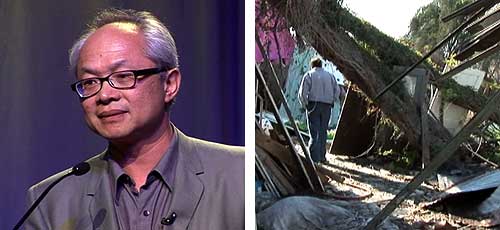EXCLUSIVE: Mel Chin describes the origins and motivations behind the nationwide art project Paydirt in a keynote address to the 2008 National Art Education Association Convention, and visits multiple sites in New Orleans adversely affected by both Hurricane Katrina and lead contamination in the soil.
New Orleans is the second most lead contaminated city in the United States. Discovering that “the disaster was in the soil before the disaster,” Chin felt he had to do something about it as an artist. Speaking before a crowd of thousands of art educators from across the country, Chin recounts, “I remember standing in the ruins of the Ninth Ward and realizing as a creative individual that I felt hopeless and inadequate. And I was flooded by this terrible insecurity that being an artist was not enough to deal with the tragedy that was before me.” Thus Paydirt, and its sister initiative, the Fundred Dollar Bill Project was born.
Fundred focuses on the creation of three million artworks (personal drawings based on the likeness of a one hundred dollar bill) by children across the United States. These artworks, a collective creative action, will be delivered to Washington D.C. to raise awareness and funding for Paydirt. Ultimately Paydirt intends to heal the environmental impact of years of pollution on a city-wide scale. As Chin explains:
I describe the Paydirt operation as having two sides, one covert and one overt, all still one project…Fundred is covert only for the time it needs to be, to gather the expression, the voices of kids. The other side, the landscape side, is overtly trying to be actively engaged in transformation, the physical and scientific and verifiable method to transform a city in need.
Together, these projects propose a solution to lead contamination as verified by scientific process, advocacy, and the self-expression of young people (who are the most affected by lead contamination). The approach extends across disciplines of art, science, and education and is sensitive to aspects of community development and urban infrastructure. Based on results, it is the project team’s hope that New Orleans can then become a model for other cities with shared post-industrial legacies.
Over five days in March, Art21 shadowed Chin at the NAEA conference and throughout New Orleans as he examined potential soil testing sites to be treated by the “Big Mud Krewe,” environmental scientists, landscape architects, and landscape architecture students at the University of Virginia. Chin visited an abandoned elementary school, whose floors were eerily littered with the detritus of papers dated August 2005, various empty construction sites, and even the backyards of communities still shaken by the storm. Though the city is clearly far from a full recovery, the drive and passion of all the various collaborators on this project inspire hope that three years later, a rejuvenated New Orleans is still possible.
If you haven’t already, be sure to watch Mel Chin: Fundred at George Jackson Academy, Art21’s video about the making of Fundred Dollar Bills at a middle school in New York City. Learn how to participate by visiting the Fundred website. And read an extensive two-part interview with Mel Chin on Paydirt and Fundred here and here.
VIDEO | Producer: Larissa Nikola-Lisa & Kelly Shindler. Camera: Larissa Nikola-Lisa. Sound: Wesley Swinnen. Editor: Lizzie Donahue & Larissa Nikola-Lisa.
